MetalMaster SJM-1.2 User manual

OPERATION MANUAL
Edition No : SJM-1.2-1
Date of Issue : 05/2020
Model SJM-1.2
Order Code S639
Motorised Swage & Jenny

2
OPERATION MANUAL
NOTE:
In order to see the type and model of the machine, please see the
specication plate. Usually found on the back of the machine. See
example (Fig.1)
Fig.1
MOTORIZED SWAGE & JENNY
MACHINE
SJM-1.2
MODEL NO.
SERIAL NO.
DATE OF MANF.
Note:
This manual is only for your reference. Owing to the continuous improvement of the
Metalmaster machine, changes may be made at any time without obligation or notice.
Please ensure the local voltage is the same as listed on the specication plate before
operating any electric machine.
Distributed by
www.machineryhouse.co.nz
MACHINE DETAILS

3
OPERATION MANUAL
C O N T E N T S:
1. GENERAL MACHINE INFORMATION
1.1 Specications.............................................................. 4
1.2 Standard Equipment................................................ 4
1.3 Identication.............................................................. 5
1.4 SJM-1.2 Dimensions................................................. 6
2. IMPORTANT INFORMATION
2.1 Safety Requirements................................................ 7
2.2 Safety Features of the Machine............................ 10
2.3 Lifting Instructions.................................................... 11
3. SETUP
3.1 Clean Up....................................................................... 12
3.2 Site Preparation......................................................... 12
3.3 Leveling The Machine............................................. 13
3.4 Electrical Installation................................................ 13
3.5 Full Load Current Rating......................................... 14
3.6 Test Run........................................................................ 14
4. OPERATION
4.1 Controls........................................................................ 15
4.2 Changing The Rolls................................................... 16
4.3 Rolls Alignment......................................................... 17
4.4 Adjusting The Fence Position............................... 17
5. MAINTENANCE
5.1 Schedule....................................................................... 18
5,2 Lubrication.................................................................. 18
5.3 Troubleshooting....................................................... 19
Spare Parts............................................................................ 20
Risk Assessment Sheets................................................... 25

4
OPERATION MANUAL
1.1 SPECIFICATION
Order Code S639
MODEL SJM-1.2
Mild Steel - Thickness Capacity (mm/gauge) 1.2 / 18
Throat Depth Maximum (mm) 240
Roll Diameter (mm) 62
Main Shafts Diameters (mm) 26
Output Drive Speed (rpm) 32
Motor Power (kW/hp) 0.75 / 1
Voltage (V ) 415
Amperage (amp) 15
Dimensions (L x W x H) (cm) 110 x 45 x 135
Nett Weight (kg) 135
1.2 ACCESSORIES INCLUDED
Roving foot pedal control
Adjustable depth guide
Spanner
Oil can
Instruction Manual
Rolls:
1 set of S1 Swaging Rolls
1 set of S2 Crimping Rolls
1 set of S3 Double Bead Rolls
1 set of S4 Necking Rolls
1 set of E1 Cutting Rolls
1 set of E2 Bevel Flange Rolls
1 set of E3 Right Angle Rolls
1 set of E4 Wiring Rolls

5
OPERATION MANUAL
1.3 IDENTIFICATION
1Main Body 7Roving Foot Pedal
2Emergency Stop Button 8Forward & Reverse Pedals
3ON Switch 9Bottom Roll Horizontal Adjustment
4OFF Switch 10 Material Guide
5Power ON Light 11 Rolls
6Isolating Switch 12 Top Roll Vertical Adjustment
1
2
3
7
9
10
12
11
45
6
8

6
OPERATION MANUAL
1.4 SJM1.2 DIMENSIONS

7
OPERATION MANUAL
DO NOT use this machine unless you have read this manual or have been instructed in the use
of this machine in its safe use and operation
This manual provides safety instructions on the proper setup, operation, maintenance, and
service of this machine. Save this manual, refer to it often, and use it to instruct other operators.
Failure to read, understand and follow the instructions in this manual may result in re or
serious personal injury—including amputation, electrocution, or death.
The owner of this machine is solely responsible for its safe use. This responsibility includes, but
is not limited to proper installation in a safe environment, personnel training and authorization
to use, proper inspection and maintenance, manual availability and comprehension, of the
application of the safety devices, integrity, and the use of personal protective equipment.
The manufacturer will not be held liable for injury or property damage from negligence,
improper training, machine modications or misuse.
WARNING
2.1 GENERAL METALWORKING MACHINE SAFETY
Always wear safety glasses or goggles.
Wear appropriate safety footwear.
Wear respiratory protection where required.
Gloves should never be worn while operating the machine, and only worn when
handling the workpiece.
Wear hearing protection in areas > 85 dBA. If you have trouble hearing someone speak
from one metre (three feet) away, the noise level from the machine may be hazardous.
DISCONNECTION THE MACHINE FROM POWER when making adjustments or servicing.
Check and adjust all safety devices before each job.
Ensure that guards are in position and in good working condition before operating.
Ensure that all stationary equipment is anchored securely to the oor.
Ensure all machines have a start/stop button within easy reach of the operator.
Each machine should have only one operator at a time. However, everyone should know
how to stop the machine in an emergency.

8
OPERATION MANUAL
Ensure that keys and adjusting wrenches have been removed from the machine before
turning on the power. Appropriate storage for tooling should be provided.
Ensure that all cutting tools and blades are clean and sharp. They should be able to cut freely
without being forced.
Stop the machine before measuring, cleaning or making any adjustments.
Wait until the machine has stopped running to clear cuttings with a vacuum, brush or rake.
Keep hands away from the cutting head and all moving parts.
Avoid awkward operations and hand positions. A sudden slip could cause the hand to move
into the cutting tool or blade.
Return all portable tooling to their proper storage place after use.
Clean all tools after use.
Keep work area clean. Floors should be level and have a non-slip surface.
Use good lighting so that the work piece, cutting blades, and machine controls can be seen
clearly. Position any shade lighting sources so that they do not cause any glare or reections.
Ensure there is enough room around the machine to do the job safely.
Obtain rst aid immediately for all injuries.
Understand that the health and re hazards can vary from material to material. Make sure all
appropriate precautions are taken.
Clean machines and the surrounding area when the operation is nished.
Use proper lock out procedures when servicing or cleaning the machines or power tools.
DO NOT
×Do not distract an operator. Horseplay can lead to injuries and should be strictly prohibited.
×Do not wear loose clothing, gloves, necktie’s, rings, bracelets or other jewellery that can be
come entangled in moving parts. Conne long hair.
×Do not handle cuttings by hand because they are very sharp. Do not free a stalled cutter
without turning the power o rst. Do not clean hands with cutting uids.
×Do not use rags or wear gloves near moving parts of machines.
×Do not use compressed air to blow debris from machines or to clean dirt from clothes.
×Do not force the machine. It will do the job safer and better at the rate for which it was
designed.
2.1 GENERAL METALWORKING MACHINE SAFETY Cont.
BEFORE OPERATING ANY MACHINE, TAKE TIME TO READ
AND UNDERSTAND ALL SAFETY SIGNS AND SYMBOLS.
IF NOT UNDERSTOOD SEEK EXPLANATION FROM YOUR
SUPERVISOR.

9
OPERATION MANUAL
2.1 GENERAL METALWORKING MACHINE SAFETY Cont.
HAZARDS ASSOCIATED WITH MACHINES include, but are not limited to:
• Being struck by ejected parts of the machinery
• Being struck by material ejected from the machinery
• Contact or entanglement with the machinery
• Contact or entanglement with any material in motion
Health Hazards (other than physical injury caused by moving parts)
• Chemicals hazards that can irritate, burn, or pass through the skin
• Airborne items that can be inhaled, such as oil mist, metal fumes, solvents, and dust
• Heat, noise, and vibration
• Ionizing or non-ionizing radiation (X-ray, lasers, etc.)
• Biological contamination and waste
• Soft tissue injuries (for example, to the hands, arms, shoulders, back, or neck) resulting
from repetitive motion, awkward posture, extended lifting, and pressure grip)
Other Hazards
• Slips and falls from and around machinery during maintenance
• Unstable equipment that is not secured against falling over
• Safe access to/from machines (access, egress)
• Fire or explosion
• Pressure injection injuries from the release of uids and gases under high pressure
• Electrical Hazards, such as electrocution from faulty or ungrounded electrical
components
• Environment in which the machine is used (in a machine shop, or in a work site)
MACHINES ARE SAFEGUARDED TO PROTECT THE OPERATOR FROM INJURY OR DEATH WITH THE
PLACEMENT OF GUARDS. MACHINES MUST NOT BE OPERATED WITH THE GUARDS REMOVED
OR DAMAGED.

10
OPERATION MANUAL
2.2 SPECIFIC SAFETY FOR SWAGE & JENNY MACHINE
Safety glasses must be worn when
operating this equipment
Dust mask must be worn when operat-
ing in high dust areas.
Long and loose hair must be contained
when operating this equipment.
Safety footwear must be worn when
operating this equipment
Close tting/protective clothing must
be worn when operating the machine
Hearing protection must be used when
operating in a noisy environment
PRE-OPERATIONAL SAFETY CHECKS
qLocate and ensure you are familiar with all machine operations and controls.
qEnsure all guards are tted, secure and functional. Do not operate if guards are missing or
faulty.
qWorking parts should be well lubricated and the dies are free of rust and dirt.
qCheck workspaces and walkways to ensure no slip/trip hazards are present.
qBe aware of other people in the area and ensure the area is clear before using equipment.
OPERATIONAL SAFETY CHECKS
qAdjust the chosen dies slowly and in small adjustments.
qTake care during the initial feeding of the workpiece into the dies.
qHold the workpiece suciently far back from the edge being fed into the dies, to allow for
the in-feed speed of the machine.
qWind handle at a slow even rate. Be aware of rotating dies
qOnly one person may operate this machine at any one time.
ENDING OPERATIONS AND CLEANING UP
qEnsure the machine is left in a safe condition after use.
qLeave the work area in a safe, clean and tidy state.
POTENTIAL HAZARDS AND INJURIES
qSharp edges and burrs.
qCrush and pinch points.
qHair/clothing getting caught in moving machine parts.
qOperator’s hands may be caught and drawn into the rotating dies.
DON’T
qDo not use faulty equipment. Immediately stop and repair suspect machinery.
qDo not attempt to form material beyond the capacity of the machine.
DO NOT use this machine unless you have been instructed in its safe use and
operation and have read and understood this manual

11
OPERATION MANUAL
2.3 LIFTING INSTRUCTIONS
On the day that the machine arrives, make sure that a crane with sucient capacity is available
to unload the machine from the vehicle. Ensure access to the chosen site is clear and that doors
and ceilings are suciently high and wide enough to receive the machine.
To handle the machine, the slings should be positioned so the machine is level when lifted.
When using slings please take note of the sling angle and the loads that apply
When the slings are at a 45° angle then each sling is
carrying the equivalent of 50% of load weight. (Fig.2.1).
When the slings are at a 90° angle then each sling will
have a weight equal to 75% of the load on each sling.
(Fig 2.2)
NOTE: THE MANUFACTURER RECOMMENDS NOT TO
EXCEED 90° ANGLE
Fig 2.2
Fig 2.1.
When lifting the machine only certied lifting
slings should be used.
Ensure that when lifting, the machine does not
tip over.
Check that the lifting slings do not interfere with
the machines controls or electrical conduits.
Failure to follow these instructions could cause
damage to the machine
LIFTING POINTS
Fig.2.3

12
OPERATION MANUAL
The unpainted surfaces of the machine have been coated with a waxy oil to protect them from
corrosion during shipment. Remove the protective coating with a solvent cleaner or a citrus
based degreaser.
Optimum performance from your machine will be achieved when you clean all moving parts or
sliding contact surfaces that are coated with rust prevented products.
It is advised to avoid chlorine based solvents, such as acetone or brake parts cleaner, as they
will damage painted surfaces and strip metal should they come in contact. Always follow the
manufacturer’s instructions when using any type of cleaning product.
3.1 CLEAN - UP
3. SETUP
3.2 SITE PREPARATION
When selecting the site for the machine, consider the largest size of workpiece that will be
processed through the machine and provide enough space around the machine for operat-
ing the machine safely. Consideration should be given to the installation of auxiliary equip-
ment. Leave enough space around the machine to open or remove doors/covers as required
for the maintenance and service as described in this manual.
It is recommended that the machine is anchored to the oor to prevent tipping or shifting. It
also reduces vibration that may occur during operation.
Machine Mounting Options
Although it is not required Metalmaster recommends that
you secure your machine to the oor. Masonry anchors
with bolts are the best way to anchor machinery, because
the anchors sit ush with the oor surface, making it easy
to unbolt and move the machine later, if needed. (Fig. 3.2)
Other methods of mounting is the use of machine mounts
which also help with the levelling of the machine and
isolating vibration. (Fig.3.3)
Fig.3.2
Fig.3.3

13
OPERATION MANUAL
3.3 MACHINE LEVELING
To set your machine up so that it operates to optimum performance, apply the following
procedure
After your machine has been anchored to a concrete slab oor, it then needs to be leveled.
Loosen the hold down bolts and place a level on the surface of the working table. Metal shims
need to be placed under corner of the base of the machine until level. Once level then tighten
the hold down bolts. (Fig. 3.4).
The machine must not rest on supports
other than those dened in Fig. 3.4
Metal Shim
Hold Down Bolt
Fig. 3.4
Place the machine near an existing power source. Make sure all power cords are protected from
trac, material handling, moisture, chemicals, or other hazards. Make sure there is access to a
means of disconnecting the power source. The electrical circuit must meet the requirements for
415V. To minimize the risk of electrocution, re, or equipment damage, these machines should
be hard wired with installation work and electrical wiring done by a qualied electrician.
NOTE : The use of an extension cord is not recommended as it may decrease the life of electrical
components on your machine.
3.4 ELECTRICAL INSTALLATION
ELECTRICAL REQUIREMENTS
Nominal Voltage.........................................415V
Cycle............................................................50 Hz
Phase...............................................Three Phase
Power Supply Circuit............................10 Amps
(Full load current rating is also on the specication plate on the motor.)

14
OPERATION MANUAL
The full-load current rating is the amperage a machine draws when running at 100% of the out-
put power. Where machines have more than one motor, the full load current is the
amperage drawn by the largest motor or a total of all the motors and electrical devices that
might operate at one time during normal operations.
Full-Load Current Rating for these machines can be found on the specication plate.
It should be noted that the full-load current is not the maximum amount of amps that the
machine will draw. If the machine is overloaded, it will draw additional amps beyond the
full-load rating and if the machine is overloaded for a long period of time, damage, overheating,
or re may be caused to the motor and circuitry.
This is especially true if connected to an undersized circuit or a long extension lead. To reduce
the risk of these hazards, avoid overloading the machine during operation and make
sure it is connected to a power supply circuit that meets the requirements.
3.5 FULLLOAD CURRENT RATING
3.6 TEST RUN
Once assembly is complete, test run the machine to ensure it is properly connected to the
power and safety components are functioning correctly. Check that the direction of the rolls
is correct by depressing each pedal on the roving foot pedals and make sure that the rolls are
rotating in the correct direction.
If the direction is incorrect, isolate the machine and have the electrician make changes to the
wiring.
Testing The Emergency Stop Button
Make sure that the emergency button has been reset.
Start the machine and then press the emergency stop button. The machine should stop and
the power should be cut o. If the machine cannot be started then th emergency stop is
working correctly. To reset the emergency stop twist the red top until it pops up.
If you nd an unusual problem during the test run, immediately stop the machine, disconnect
it from power, and x the problem BEFORE operating the machine again. The Troubleshooting
table in the Maintenance section of this manual may be able to help. If the problem persists the
contact your dealers service technician.

15
OPERATION MANUAL
4. OPERATION
This machine will perform many types of operations that are beyond the scope of this manual.
Many of these operations can be dangerous or deadly if performed incorrectly.
The instructions in this section are written with the understanding that the operator has the
necessary knowledge and skills to operate this machine. If at any time you are experiencing
diculties performing any operation, stop using the machine!
If you are an inexperienced operator, we strongly recommend that you read books, trade
articles, or seek training from an experienced operator before performing any unfamiliar
operations. Above all, your safety should come rst!
4.1 CONTROLS
The purpose of this control overview is to provide the novice machine operator with a basic
understanding of how the machine is used during operation, and the machine controls and
what they do. It also helps the operator to understand if they are discussed later in this manual.
Fig. 4.1
Fig. 4.2
Fig. 4.3
A. ON Button. Switches the power ON to the machine.
(Fig.4.1)
B. OFF Button. Switches the power OFF to the machine.
C. Power Light. Illuminates when power is switched on.
D. Main Isolating Switch. Isolates the machine from the
power supply. (Fig.4.1)
E. Emergency Stop Button. When pressed stops the
machine and locks access to the power supply. To
unlock and reset the stop button twist the red top
in the direction of the arrows to allow the red button
to pop up. (Fig.4.2)
F. Right Pedal. When pressed and held down the rolls
rotate in a clock wise direction (Fig.4.3)
G. Left Pedal. When pressed and held down the rolls
rotate in a anti clock wise direction (Fig.4.3)
AB C
D
E
G
F

16
OPERATION MANUAL
4.2 CHANGING THE ROLLS
A variety of roll sets are available for various applications that can be done on this machine.
The rst process that needs to be done is the selection of the roll set required.
Fig.4.5
Once the roll set has been chosen then they need to be
tted to the machine.
To change the rolls,
1. DISCONNECT THE MACHINE FROM THE POWER SUPPLY
2. Use the included spanner to remove the retaining nuts
(Fig.4.6)
NOTE: • The upper retaining nut is a left-hand thread.
Rotate it clockwise to loosen and counterclockwise to
tighten.
• The lower retaining nut is a right-hand threads. Rotate
it counterclockwise to loosen and clockwise to tighten.
3. Remove the existing roll set, then install the new roll
set and secure with the retaining nuts.
Fig. 4.6
Nuts
4.1 CONTROLS Cont. H
H. Top Roll Adjusting Handle. With the bottom roller
being xed, all the adjustment up and down is made
by the top roll which is controlled by the handle.
(H in Fig.4.4)
Fig. 4.4
Standard Roll Sets

17
OPERATION MANUAL
4.3 ROLLS ALIGNMENT
Before operations, and whenever you change the roll sets,
always make sure the rolls are aligned to ensure properly
formed beads. (Fig.4.7)
To align the Rolls,
1. Lower the upper roll until it almost touches the lower
roll.
2. Adjust the lever (J in Fig. 4.8), to move the lower shaft in or
out until the rolls are correctly aligned.
Fig.4.7
Fig.4.8
Not Aligned
Aligned
4.4 ADJUSTING THE FENCE POSITION
To create straight, consistent forms that are parallel
with an edge of the workpiece, the fence is used
to guide the workpiece in a straight line at a set
distance from the rolls.
To adjust the fence loosen the two clamps, one
on each side of the machine, then move the fence
toward or away from the rolls as required, then
re-tighten the two clamps. (Fig.4.10)
Fig.4.10
J
K

18
OPERATION MANUAL
5. MAINTENANCE
5.1 SCHEDULE
For optimum performance from your machine, follow this maintenance schedule and refer to
any specic instructions given in the maintenance section.
Daily Check
• Loose mounting bolts.
• Worn or damaged wires.
• Check/adjust lubrication.
• Any other unsafe condition.
5.2 LUBRICATION
The recommended lubrication in this manual is based on light-to-medium usage. Keeping in
mind that lubrication helps to protect the value and operation of the machine, these
lubrication tasks may need to be performed more frequently than recommended here,
depending on usage.
Failure to follow reasonable lubrication practices as instructed in this manual could lead to
premature failure of machine parts and possibly void the warranty.
2. Grease point on the back of the guard and on the shafts and fence mechanism.
This needs to be greased WEEKLY (Fig.5.2)
3. Unpainted machined surfaces need to be covered with a light oil to prevent rust.
These need to be covered with a light oil DAILY
4. Oil the Upper Shaft Elevation Crank thread
This needs to be covered with a light oil WEEKLY
1. Oil points on the machine should be oiled
with 30 grade oil
These need to be oiled WEEKLY
(Fig. 5.1)
Fig.5.1
Fig.5.2

19
OPERATION MANUAL
Review the troubleshooting and procedures in this section if a problem develops with your
machine. If you need replacement parts then follow the procedure in beginning of the spare
parts section or if additional help with a procedure is required, then contact you distributor.
Note: Make sure you have the model of the machine, serial number,and manufacture date
before calling.
5.2 TROUBLESHOOTING
Symptoms Possible Cause Possible Solution
Machine does not
start or a breaker
trips.
1. Main power switch in OFF position/at fault.
2. Plug/receptacle at fault/wired wrong.
3. Incorrect power supply voltage/circuit size.
4. Power supply circuit breaker tripped or
fuse blown.
5. Motor wires connected incorrectly.
6. Contactor not energized/has poor contacts.
7. Wiring open/has high resistance.
8. Foot pedal switch at fault.
9. Start capacitor at fault.
10. Centrifugal switch at fault
11. Motor at fault.
1. Rotate switch to ON position. Replace.
2. Test for good contacts; correct the wiring.
3. Ensure correct power supply voltage/circuit size.
4. Ensure circuit is sized correctly and free of shorts.
Reset circuit breaker or replace fuse.
5. Correct motor wiring connections.
6. Test all legs for power/replace.
7. Check/x broken, disconnected, or corroded wires.
8. Test/replace switch.
9. Test/replace.
10. Adjust/replace centrifugal switch if available.
11. Test/repair/replace.
Machine stalls or is
underpowered.
1. Machine undersized for task.
2. Wrong workpiece material.
3. Motor overheated.
4. Motor wired incorrectly.
5. Contactor not energized/has poor contacts.
6. Plug/receptacle at fault.
7. Gearbox at fault.
8. Run capacitor at fault.
9. Centrifugal switch at fault.
10. Foot pedal switch at fault.
11. Motor bearings at fault
1. Reduce downward pressure of upper roller.
2. Use correct type/size of sheet metal stock.
3. Clean motor, let cool, and reduce workload.
4. Wire motor correctly.
5. Test all legs for power/replace.
6. Test for good contacts/correct wiring.
7. Replace broken or slipping gears.
8. Test/replace.
9. Adjust/replace centrifugal switch if available.
10. Test/replace switch.
11. Test by rotating shaft; rotational grinding/loose
shaft requires bearing replacement
Machine has
vibration or noisy
operation.
1. Motor or component loose.
2. Motor fan rubbing on fan cover.
3. Motor mount loose/broken.
4. Machine incorrectly mounted on oor.
5. Roll(s) at fault/incorrectly installed.
6. Centrifugal switch at fault.
7. Motor bearings at fault.
1. Inspect/replace damaged bolts/nuts, and
re-tighten with thread-locking uid.
2. Fix/replace fan cover; replace loose/damaged fan.
3. Tighten/replace.
4. Tighten mounting bolts; relocate/shim machine.
5. Ensure rolls are correctly installed, replace if
necessary.
6. Adjust/replace centrifugal switch if available.
7. Test by rotating shaft; rotational grinding/loose
shaft requires bearing replacement.
Workpiece dorms,
kinks, or is crushed
during operation.
1. Excessive rolling pressure.
2. Rolls not properly aligned.
3. Rolls(s) are damaged.
1. Reduce downward pressure of upper roll.
2. Align rolls (Page 18).
3. Replace rolls(s)
Bead is not deep
enough.
1. Not enough rolling pressure 1. Increase downward pressure of upper roll.
Workpiece does
not move when
rollers rotate.
1. Not enough rolling pressure.
2. Grease/oil on workpiece/rolls, causing
rolls to slip against workpiece
1. Increase downward pressure of upper roll.
2. Thoroughly clean workpiece/rolls to prevent
slipping

20
OPERATION MANUAL
SPARE PARTS SECTION
The following section covers the spare parts diagrams and lists that were current at the time
this manual was originally printed. Due to continuous improvements of the machine, changes
may be made at any time without notication.
HOW TO ORDER SPARE PARTS
1. Have your machines model number, serial number & date of manufacture
on hand, these can be found on the specication plate mounted on the machine
2. A scanned copy of your parts list/diagram with required spare part/s
identied
3. Go to www.machineryhouse.com.au/contactus and ll out the inquiry form attaching a
copy of scanned parts list.
CONTENTS
Wiring Diagram.......................................................... 21
SJM-1.2 Cabinet Diagram....................................... 22
SJM-1.2 Spare Parts Diagram................................ 23
SJM-1.2 Spare Parts List.......................................... 24
Edition No : SJM-1.2-1
Date of Issue : 05/2020
Model SJM-1.2
Order Code S639
Motorised Swage & Jenny
Table of contents
Other MetalMaster Industrial Equipment manuals
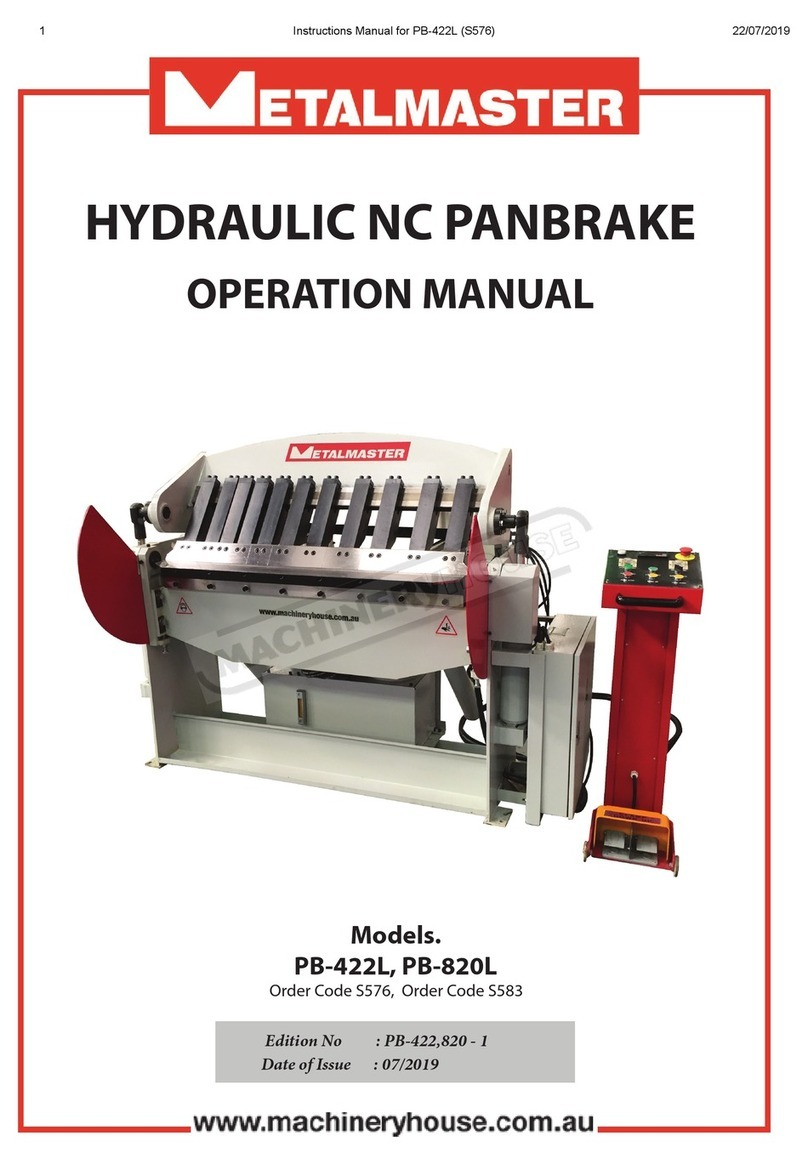
MetalMaster
MetalMaster PB-422L User manual
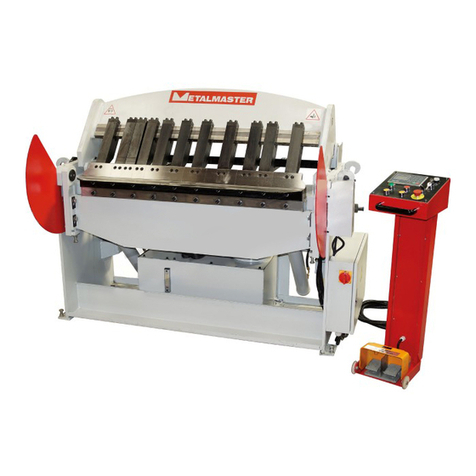
MetalMaster
MetalMaster PB-440A User manual
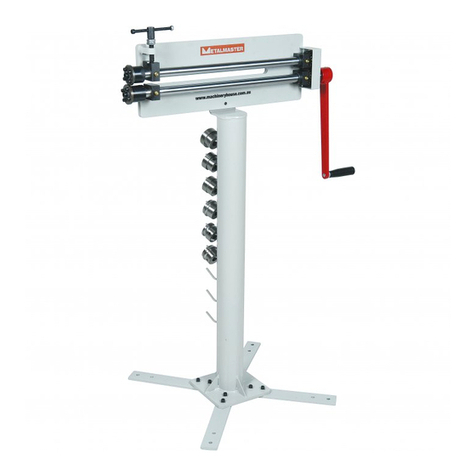
MetalMaster
MetalMaster SJ-24D User manual
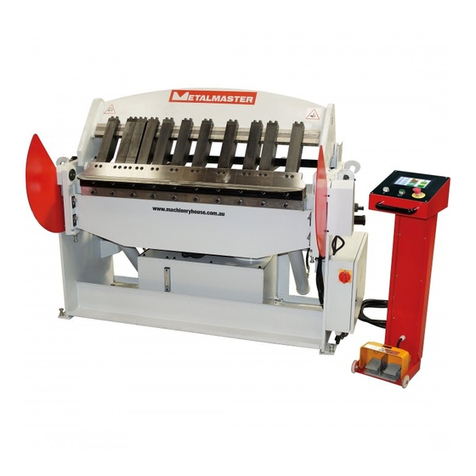
MetalMaster
MetalMaster PB-440T User manual
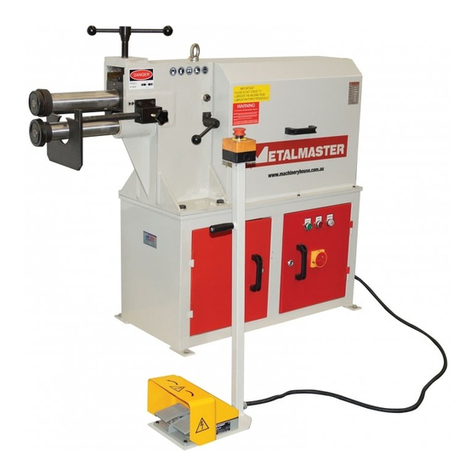
MetalMaster
MetalMaster SJM-2.5 User manual
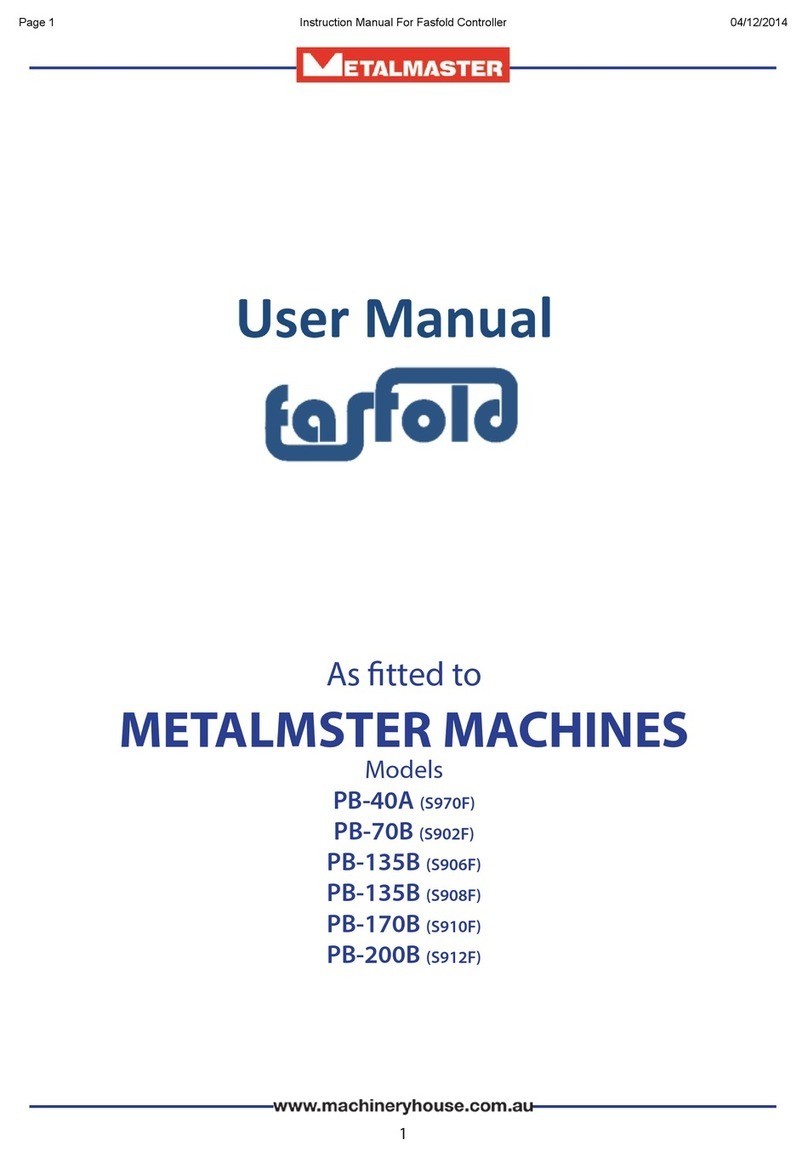
MetalMaster
MetalMaster Fasfold PB-40A User manual
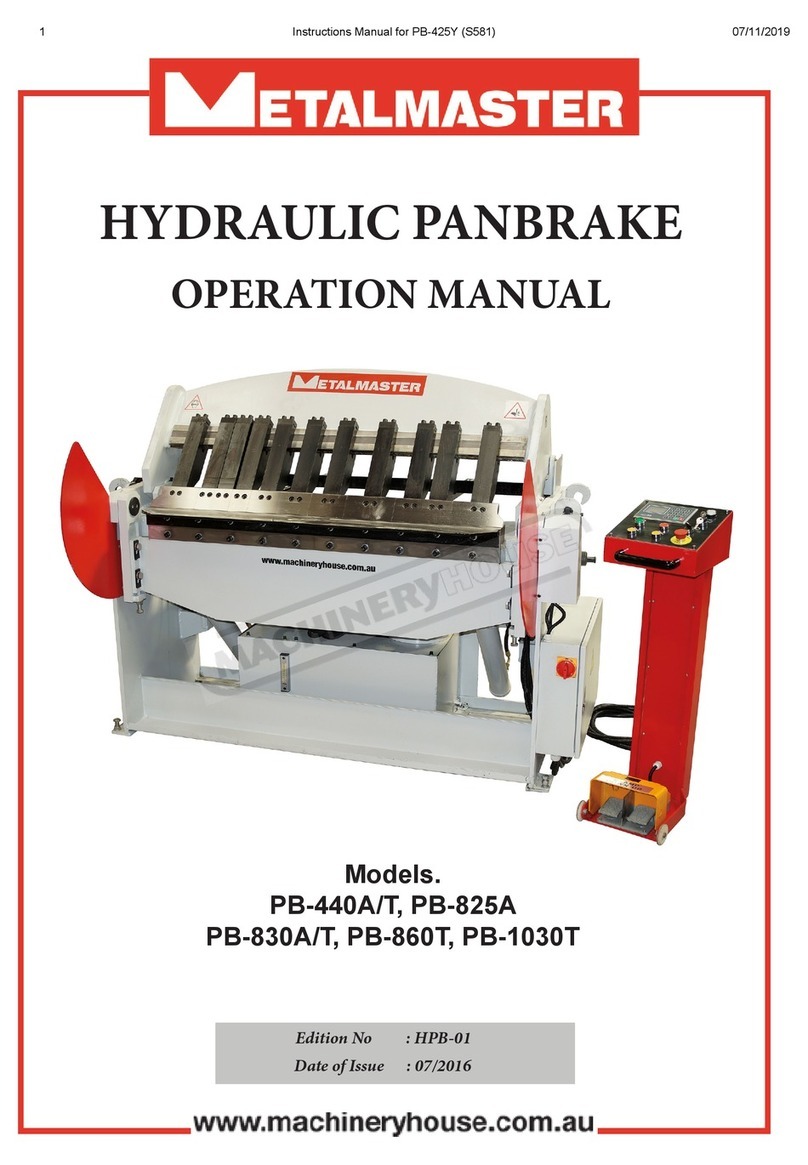
MetalMaster
MetalMaster PB-440A/T User manual
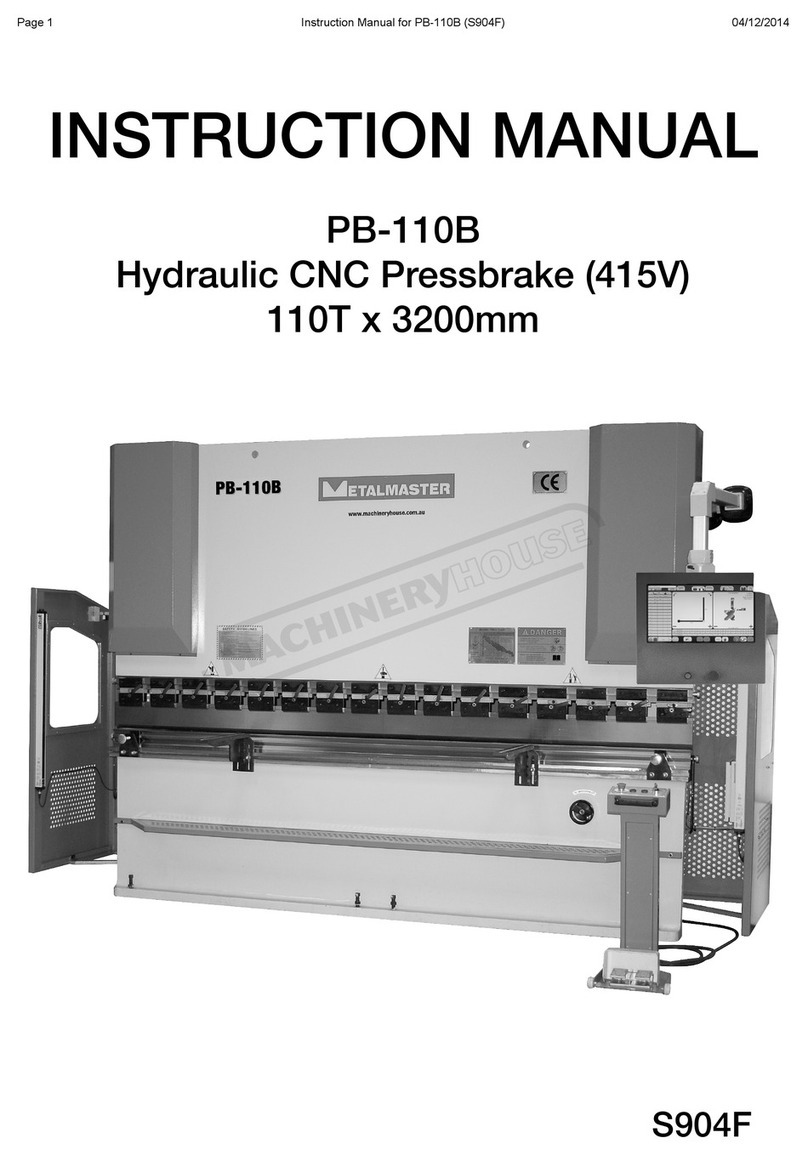
MetalMaster
MetalMaster PB-110B User manual

MetalMaster
MetalMaster PB-CL Series User manual

















